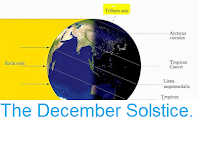An annular eclipse of the Sun (eclipse in which the Moon passes in front of the Sun, but does not completely block it, leaving visible ring of light) will be visible from parts of Angola, Argentina and Chile on Sunday 26 February 2017, with a partial eclipse visible from much of the rest of Sub-Saharan Africa, Antarctica, the southern half of South America and the islands of the South Atlantic.
The
path of the 26 February 2017 Annular Solar Eclipse. The annular eclipse will be
visible along the central dark grey path. A partial eclipse will be
visible from the shaded areas; in the lighters area the full eclipse
will not be visible as it will have started before dawn (west) or will
continue after sunset (east). The solid red lines are the Equator and the
Greenwich Meridian, the dotted red lines are the Topics of Cancer (north) and Capricorn (south). HM Nautical Almanac Office.
Eclipses
are a product of the way the Earth, Moon and Sun move about
one-another. The Moon orbits the Earth every 28 days, while the Earth
orbits the Sun every 365 days, and because the two Sun and Moon appear
roughly the same size when seen from Earth, it is quite possible for the
Moon to block out the light of the Sun. At first sight this would seem
likely to happen every month at the New Moon, when the Moon is on the
same side of the Earth as the Sun, and therefore invisible (the Moon
produced no light of its own, when we see the Moon we are seeing
reflected sunlight, but this can only happen when we can see parts of
the Moon illuminated by the Sun).
The relative positions of the Sun, Moon and Earth during a Solar eclipse. Starry Night.
An Annular Eclipse is a type of Solar Eclipse, in which the Moon passes between the Earth and the Sun while the moon is close to aphelion (when it is furthest from the Earth). The Moon has a variable orbit, getting considerably closer and further from the Earth at different times, which alters its size as seen from the Earth. Thus when it is at its furthest from the Earth it appears considerably smaller than the Sun so an eclipse occurring at this time will produce a ring of sunlight, rather than a period of darkness. A Partial Annular Eclipse resembles a regular Partial Eclipse, in that the light of the Sun will be partially blocked by the Moon passing in from of it, though the disk of the Moon will be smaller.

An Annular Eclipse on 20 May 2013, photographed from Middlegate, Nevada. Wikipedia.
However
the Moon does not orbit in quite the same plane as the Earth orbits the
Sun, so the Eclipses only occur when the two orbital planes cross
one-another; this typically happens two or three times a year, and
always at the New Moon. During Total Eclipses the Moon entirely blocks
the light of the Sun, however most Eclipses are Partial, the Moon only
partially blocks the light of the Sun.
How the differing inclinations of the Earth and Moon's orbits prevent us having an eclipse every 28 days. Starry Skies.
Although the light of the Sun is reduced during an Eclipse, it is still extremely dangerous to look directly at the Sun, and eclipses should only be viewed with specialized equipment.
Animation showing the shadow of the Moon at five minute intervals on Sunday 26 February 2017. Andrew Sinclair/HM Nautical Almanac.
See also...
Follow Sciency Thoughts on Facebook.










